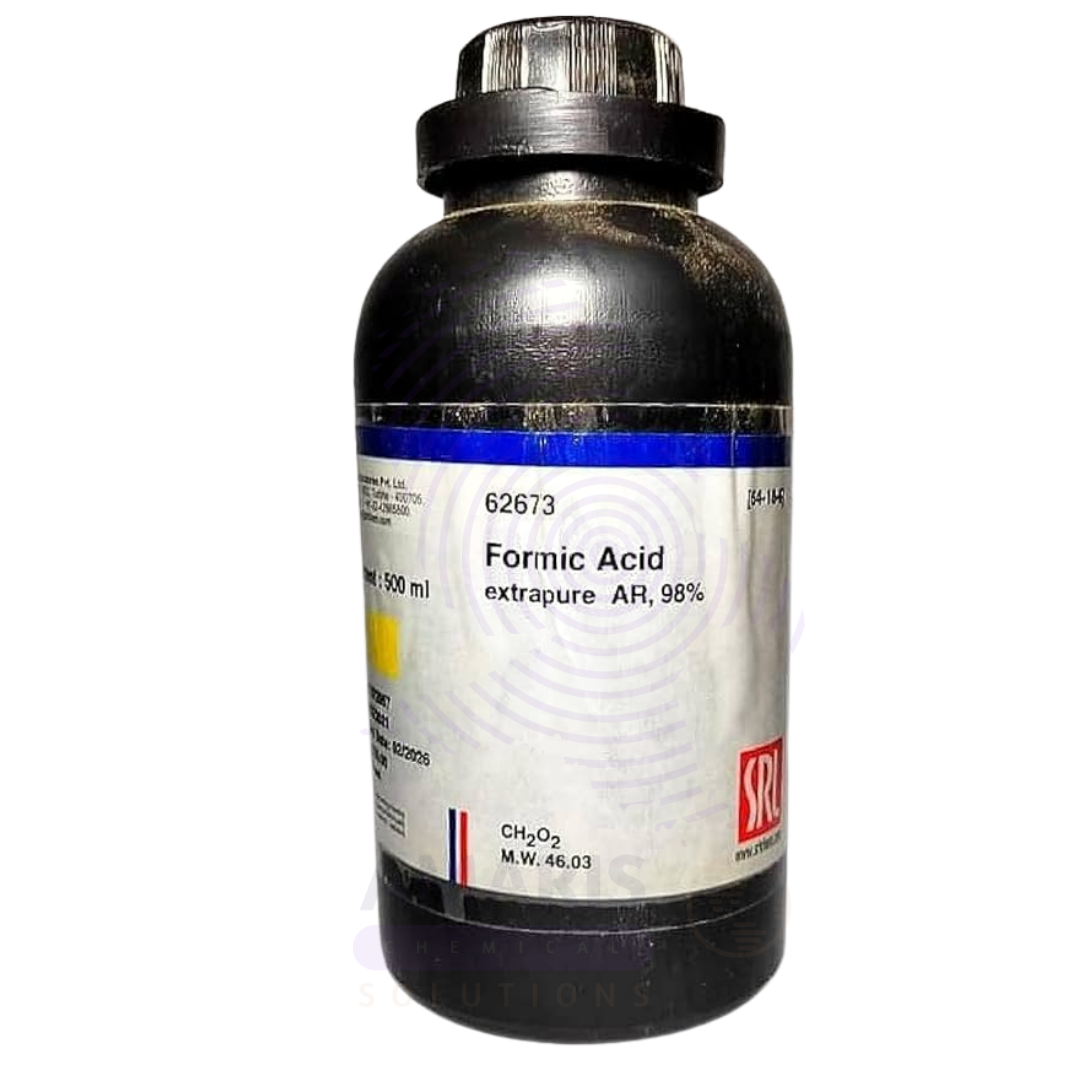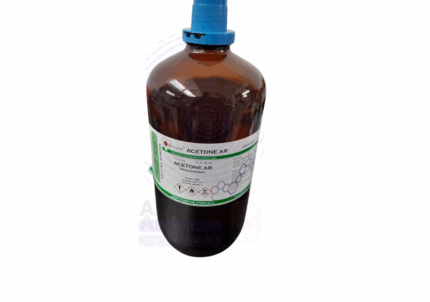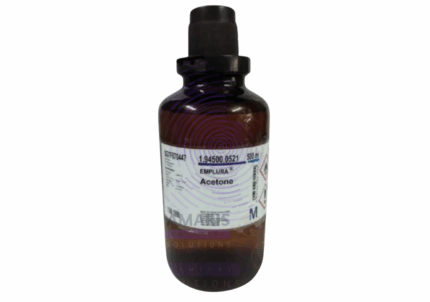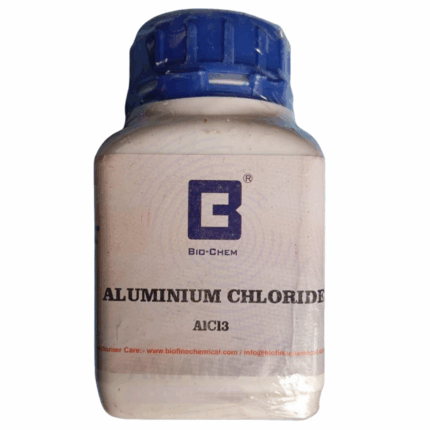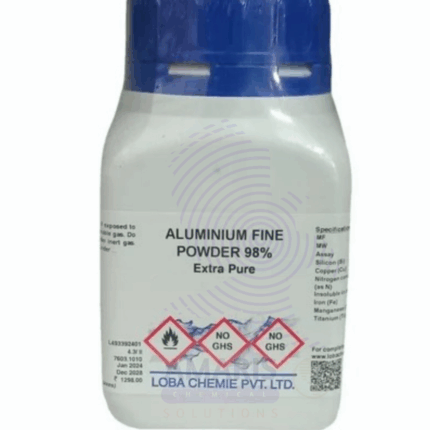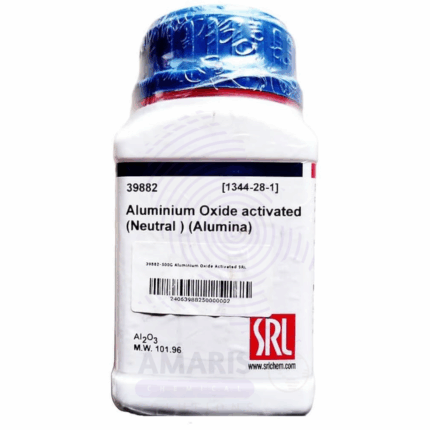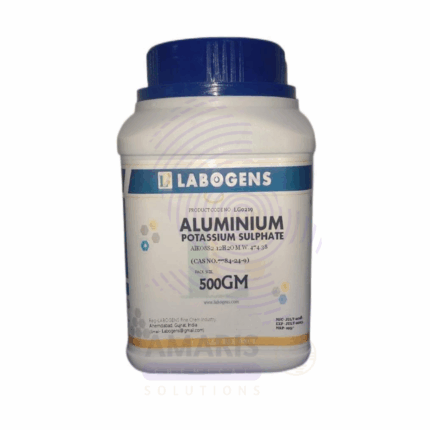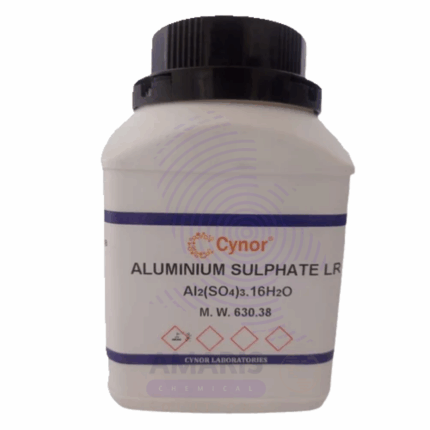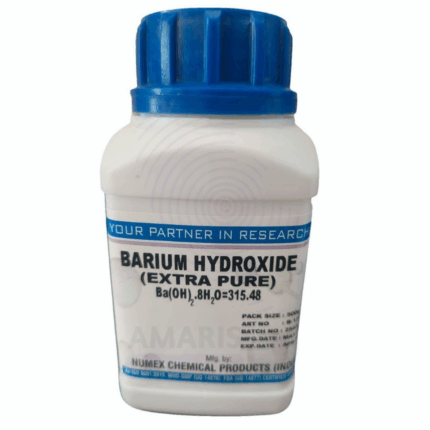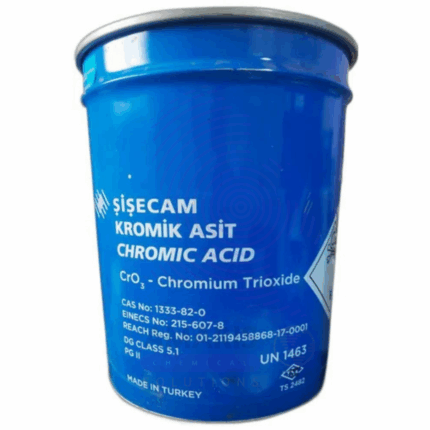


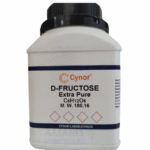
Formic Acid Extra Pure
$ 26.00 Original price was: $ 26.00.$ 25.76Current price is: $ 25.76.
Formic Acid Extra Pure is a colorless, pungent-smelling liquid with exceptional purity, making it ideal for high-precision laboratory and industrial applications. It is the simplest carboxylic acid and serves as a key reagent in organic synthesis, chromatography, and chemical analysis. Its high acidity and reducing properties make it useful in textile dyeing, leather tanning, electroplating baths, and as a preservative in livestock feed. In the lab, it is also used to adjust pH in sensitive reactions and in protein and peptide analysis. The extra pure grade ensures minimal contamination, which is critical for research-grade and analytical procedures.
Formic Acid Extra Pure
Primary Uses
- Analytical reagent:
Used in chromatography (e.g., HPLC) and mass spectrometry as a mobile phase additive to enhance ionization and improve peak resolution. - pH modifier and acidifying agent:
Acts as a strong acid in titrations and is commonly employed to adjust pH in various chemical and biochemical experiments.
Secondary Uses
- Sample preservation and fixation:
Sometimes used in tissue preservation and histology as a fixative or as a component of fixative solutions. - Intermediate in organic synthesis:
Serves as a building block or reducing agent in synthetic reactions, including esterification, formylation, and dehydrogenation processes. - Microbial and biochemical studies:
Applied in studies involving formate metabolism, microbial resistance, or enzyme activity related to formate dehydrogenase.
| PACK SIZE |
2.5 Litres Glass bottle |
|---|
1. Basic Identification Attributes
- Chemical Name: Formic Acid
- Chemical Formula: HCOOH
- CAS Number: 64-18-6
- Molecular Weight: 46.03 g/mol
- Grade: Extra Pure (Laboratory Reagent Grade)
- Appearance: Colorless, fuming liquid
- Odor: Pungent, penetrating, acidic odor
2. Physical & Chemical Properties
- Boiling Point: 100.8 °C
- Melting Point: 8.4 °C
- Density: 1.22 g/cm³ at 20 °C
- Solubility: Completely miscible with water, alcohols, ether
- pH: Strongly acidic in aqueous solutions
- Vapor Pressure: Moderate (~43 mmHg at 25 °C)
- Reactivity: Corrosive to metals and organic tissue
3. Safety & Hazard Attributes
- Hazard Classification: Corrosive, Toxic
- GHS Symbols: 🧪 (Corrosive), ⚠️ (Health hazard)
- Hazard Statements:
- H314: Causes severe skin burns and eye damage
- H302: Harmful if swallowed
- H332: Harmful if inhaled
- H290: May be corrosive to metals
- PPE Requirements:
- Chemical-resistant gloves (nitrile, neoprene)
- Lab coat and apron
- Safety goggles or face shield
- Use only in a well-ventilated area or fume hood
- First Aid Measures:
- Inhalation: Move to fresh air, seek medical attention
- Skin Contact: Rinse with plenty of water, remove contaminated clothing
- Eye Contact: Rinse immediately with water for at least 15 minutes
- Ingestion: Rinse mouth, do NOT induce vomiting, seek immediate medical help
4. Storage & Handling Attributes
- Storage Conditions:
- Store in tightly sealed, corrosion-resistant containers
- Keep in a cool, dry, well-ventilated area away from oxidizers and bases
- Protect from direct sunlight and moisture
- Handling Notes:
- Handle with care due to corrosive and toxic properties
- Avoid contact with skin, eyes, and clothing
- Neutralize small spills with sodium bicarbonate solution
5. Regulatory & Compliance Attributes
- UN Number: UN1779
- DOT/ADR/IATA Classification: Class 8 – Corrosive substances
- Regulatory Notes:
- Subject to OSHA workplace limits
- Listed in REACH and other chemical safety inventories
6. Laboratory Applications
- Primary Uses:
- pH adjustment and titrations in analytical chemistry
- Intermediate in organic synthesis (e.g., esters, formylation)
- Coagulating agent in rubber production
- Fixative in histology
- Secondary Uses:
- Preservative and antibacterial agent in animal feed (with caution)
- Used in dyeing and finishing textiles
- Fuel cells as a hydrogen carrier (direct formic acid fuel cells)
SAFETY PRECAUTIONS
Personal Protective Equipment (PPE):
- Wear lab coat, nitrile gloves, and chemical-resistant goggles.
- Use a face shield for splash protection during large volume handling.
- Ensure work is performed in a fume hood or well-ventilated area.
Handling:
- Avoid contact with skin, eyes, and clothing.
- Do not breathe vapors or mists.
- Handle with extreme care due to corrosive and volatile nature.
- Wash hands thoroughly after use.
Storage:
- Store in a tightly sealed container in a cool, dry, well-ventilated area.
- Keep away from heat, sparks, and sources of ignition.
- Avoid storing near strong oxidizers, alkalis, or reducing agents.
- Use corrosion-resistant storage containers.
FIRST AID MEASURES
Inhalation:
- Move the person to fresh air immediately.
- Provide oxygen if breathing is difficult.
- Seek medical attention promptly.
Skin Contact:
- Immediately flush skin with plenty of water for at least 15 minutes.
- Remove contaminated clothing and shoes.
- Seek medical advice for persistent irritation or burns.
Eye Contact:
- Rinse cautiously with water for several minutes.
- Remove contact lenses if easy to do.
- Continue rinsing and seek urgent medical attention.
Ingestion:
- Rinse mouth with water.
- Do not induce vomiting.
- Seek immediate medical help—can cause serious internal burns.
FIRE FIGHTING MEASURES
Flammability:
- Flammable liquid with flash point around 50°C.
- Vapors may form explosive mixtures with air.
Extinguishing Media:
- Use alcohol-resistant foam, dry chemical, or CO₂.
- Water spray may be used to cool containers but should not be used directly on fire.
Hazardous Combustion Products:
- Produces toxic gases including carbon monoxide (CO), carbon dioxide (CO₂), and formic acid vapors.
Firefighter Protection:
- Wear full protective gear and self-contained breathing apparatus (SCBA).
- Avoid exposure to combustion fumes and runoff.


 Preservatives(food)
Preservatives(food) Flavor Enhancers
Flavor Enhancers Acidulants
Acidulants Sweeteners
Sweeteners Antioxidants
Antioxidants Colorants(food)
Colorants(food) Nutraceutical Ingredients (food)
Nutraceutical Ingredients (food) Nutrient Supplements
Nutrient Supplements Emulsifiers
Emulsifiers
 Collectors
Collectors Dust Suppressants
Dust Suppressants Explosives and Blasting Agents
Explosives and Blasting Agents Flocculants and Coagulants
Flocculants and Coagulants Frothers
Frothers Leaching Agents
Leaching Agents pH Modifiers
pH Modifiers Precious Metal Extraction Agents
Precious Metal Extraction Agents
 Antioxidants(plastic)
Antioxidants(plastic) Colorants (Pigments, Dyes)
Colorants (Pigments, Dyes) Fillers and Reinforcements
Fillers and Reinforcements Flame Retardants
Flame Retardants Monomers
Monomers Plasticizers
Plasticizers Polymerization Initiators
Polymerization Initiators Stabilizers (UV, Heat)
Stabilizers (UV, Heat)
 Antifoaming Agents
Antifoaming Agents Chelating Agents
Chelating Agents Coagulants and Flocculants
Coagulants and Flocculants Corrosion Inhibitors
Corrosion Inhibitors Disinfectants and Biocides
Disinfectants and Biocides Oxidizing Agents
Oxidizing Agents pH Adjusters
pH Adjusters Scale Inhibitors( water)
Scale Inhibitors( water)
 Antioxidants(cosmetic)
Antioxidants(cosmetic) Emollients
Emollients Fragrances and Essential Oils
Fragrances and Essential Oils Humectants
Humectants Preservatives
Preservatives Surfactants(cosmetic)
Surfactants(cosmetic) Thickeners
Thickeners UV Filters
UV Filters
 Fertilizers
Fertilizers Soil Conditioners
Soil Conditioners Plant Growth Regulators
Plant Growth Regulators Animal Feed Additives
Animal Feed Additives Biostimulants
Biostimulants Pesticides (Herbicides, Insecticides, Fungicides)
Pesticides (Herbicides, Insecticides, Fungicides)
 Active Pharmaceutical Ingredients (APIs)
Active Pharmaceutical Ingredients (APIs) Excipients
Excipients Solvents(pharmaceutical)
Solvents(pharmaceutical) Antibiotics
Antibiotics Antiseptics and Disinfectants
Antiseptics and Disinfectants Vaccine Adjuvants
Vaccine Adjuvants Nutraceutical Ingredients (pharmaceutical)
Nutraceutical Ingredients (pharmaceutical) Analgesics & Antipyretics
Analgesics & Antipyretics
 Analytical Reagents
Analytical Reagents Solvents(lab)
Solvents(lab) Chromatography Chemicals
Chromatography Chemicals Spectroscopy Reagents
Spectroscopy Reagents microbiology-and-cell-culture-reagents
microbiology-and-cell-culture-reagents Molecular Biology Reagents
Molecular Biology Reagents Biochemical Reagents
Biochemical Reagents Inorganic and Organic Standards
Inorganic and Organic Standards Laboratory Safety Chemicals
Laboratory Safety Chemicals Specialty Laboratory Chemicals(Special Laboratory Equipment)
Specialty Laboratory Chemicals(Special Laboratory Equipment)
 Demulsifiers
Demulsifiers Hydraulic Fracturing Fluids
Hydraulic Fracturing Fluids Scale Inhibitors(oil)
Scale Inhibitors(oil) Surfactants(oil)
Surfactants(oil) Drilling Fluids
Drilling Fluids
 Dyes and Pigments
Dyes and Pigments Bleaching Agents
Bleaching Agents Softening Agents
Softening Agents Finishing Agents
Finishing Agents Antistatic Agents
Antistatic Agents
 Admixtures
Admixtures Waterproofing Agents
Waterproofing Agents Sealants and Adhesives
Sealants and Adhesives Curing Compounds
Curing Compounds Concrete Repair Chemicals
Concrete Repair Chemicals Anti-Corrosion Coatings
Anti-Corrosion Coatings
 Surfactants(cleaning)
Surfactants(cleaning) Builders
Builders Enzymes
Enzymes Solvents (Cleaning)
Solvents (Cleaning) Fragrances
Fragrances
 Electronic Chemicals
Electronic Chemicals Catalysts
Catalysts Lubricants
Lubricants Photographic Chemicals
Photographic Chemicals Refrigerants
Refrigerants Automotive chemicals
Automotive chemicals Pyrotechnic Chemicals
Pyrotechnic Chemicals
 Biodegradable Surfactants
Biodegradable Surfactants Bio-based Solvents
Bio-based Solvents Renewable Polymers
Renewable Polymers Carbon Capture Chemicals
Carbon Capture Chemicals Wastewater Treatment Chemicals
Wastewater Treatment Chemicals
 Pigments
Pigments Solvents(paint)
Solvents(paint) Specialty Coatings
Specialty Coatings Binders/Resins
Binders/Resins Additives
Additives Driers
Driers Anti-Corrosion Agents
Anti-Corrosion Agents Functional Coatings
Functional Coatings Application-Specific Coatings
Application-Specific Coatings
 Fresh Herbs
Fresh Herbs Ground Spices
Ground Spices Whole Spices
Whole Spices Spice Blends
Spice Blends Dried Herbs
Dried Herbs
 Leavening Agents
Leavening Agents Dough Conditioners
Dough Conditioners Flour Treatments
Flour Treatments Fat Replacers
Fat Replacers Decoratives
Decoratives Preservatives(baking)
Preservatives(baking)
 Plasticizers & Softeners
Plasticizers & Softeners Reinforcing Agents
Reinforcing Agents Adhesion Promoters
Adhesion Promoters Vulcanizing Agents
Vulcanizing Agents Antidegradants
Antidegradants Blowing Agents
Blowing Agents Fillers & Extenders
Fillers & Extenders Accelerators & Retarders
Accelerators & Retarders
